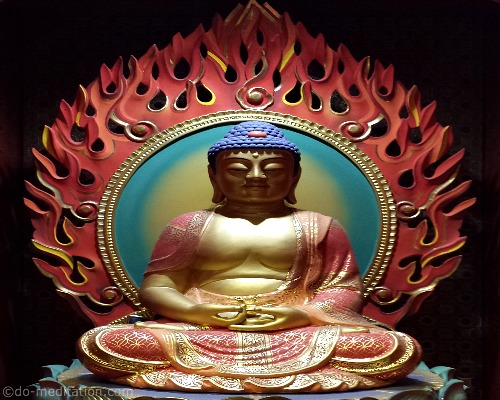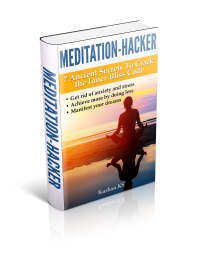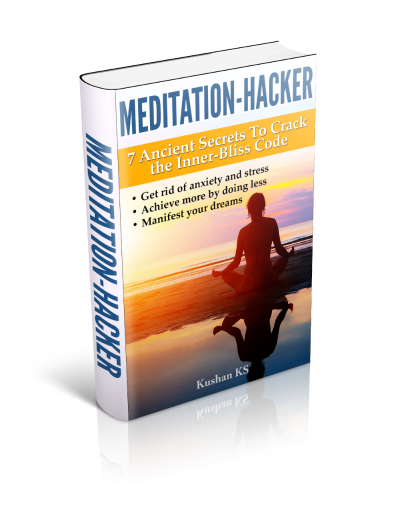Lotus Posture without Numb Painful Legs
"Sitting in full-lotus is a meditation by itself with nothing more left to be done"- Master Dogen

The question meditators often ask is how to do the lotus posture without getting numb painful legs.
Pain and numbness in the legs, sometimes unbearable, is a common complaint during meditation. It is known to make people quit meditation and remains one of the biggest stumbling blocks to an effective practice.
The sensation of numbness and pain in the legs can be so overpowering that it can distract you from the meditation completely.
When that happens, meditation is reduced to a sorry, painful struggle instead of a soothing, calming and uplifting experience.
This need not be the case though.
It is a myth that numbness in legs during meditation is caused by lack of blood circulation. Not true. It results from nerve pinch.
The awkward pressing of the sciatic nerves, which begin in the lower back, run through the buttock and down to the foot, passing through the back of the knees, is what leads to the numbness.
And this is NOT damaging to the tissues of your legs.
Some people have convinced themselves otherwise. They believe they can get gangrene from the 'lack of circulation.' Nothing could be further from the truth.
If the gangrene hypothesis were really true, practicing Buddhists and other serious meditators would all be amputees.
Numbness in the legs during long periods of sitting is pretty normal. So relax.
Follow these eight simple steps to do the lotus posture without getting numb, painful legs.
1) Stretching
Stiff muscles and lack of flexibility make it hard to sit in the lotus position. Some of us are so stiff that even the half lotus or cross-legged position is out of reach.
Do yoga or pilates to improve flexibility. They loosen and tone up the muscles in your legs making long sits easy.
If you don't have spare time for yoga, spend five minutes every day stretching your hamstring and groin muscles.
2) Loose-fitting clothes
Never meditate in tight fitting clothes. Tight jeans or trousers are a definite no.
Wear soft, loose clothes that do not constrict the blood flow and allow for the skin to breathe.
3) Use cushions
A pair of comfortable cushions - one for the floor (zabuton) and one to sit upon (zafu) - that help you maintain an erect posture will reduce the discomfort in your legs considerably.
Ensure that the cushion you sit on, zafu, is neither too soft nor too hard.
The right cushion spreads your weight evenly around your spine and small of your back without excessively loading your thighs and knees.
The floor cushion, zabuton, supports the thighs and knees and takes the pressure off your ankles and feet. This aids in blood circulation and reduces numbness.
4) PMR
Do progressive muscle relaxation of the legs for half a minute prior to meditation. It will not only reduce your pain and numbness, but also improve the quality of your sit.
5) Relax your body
Before starting meditation, spend a few moments relaxing your body into a comfortable sitting position.
Adjust your legs, back, neck and any other body part that helps you find your sweet spot.
The more comfortable you are at the beginning, the less your legs will hurt or get numb during meditation.
6) Progress slowly
Take your time to progress from Burmese to half-lotus to full-lotus rather than trying full-lotus from the get go.
Even after two decades of meditation, I still can't do the full-lotus if someone put a gun to my head. Let's accept the fact that quite a few of us are simply not flexible enough to do it comfortably.
Start with the Burmese position and when your body adjusts to it, give the half-lotus a try. After you conquer the half lotus position, try doing the full-lotus.
7) Shake them!
Feel free to move your legs and alternate with other sitting positions, if the pain is unbearable during meditation.
Don't be obsessive with maintaining your posture.
Remember meditation is not self-torture. Change your position if you are uncomfortable.
Never let the pain get so high that it pervades your mind and you can't stop thinking of it. Stretch out your legs and switch to a position where the pain subsides.
8) Use a chair
Old age or a medical condition can result in sore knees. If you have chronic pain in your knees, then meditate on a chair.
Over-stretching the knees in a cross-legged position, especially in full-lotus, is not advisable. It will worsen their condition.
Master Dogen said sitting in full-lotus was a meditation by itself, but that does not imply that sitting in full-lotus is the only way to meditate.
Using your present level of physical conditioning as a guide, pick the most comfortable posture. In time, as you start feeling more comfortable with it, try a more difficult one.
Again, the lotus posture is not essential for a successful meditation practice, so feel no compulsion to progress toward it.
Numb, painful legs are a reality for both beginner and advanced meditators. Even after observing all the above steps, you will still suffer from them from time to time.
Whenever the numbness happens, just observe the phenomenon. Witness it. Stay detached. Do not engage it.
The pain occurs when you tense up and get involved. Keep calm and simply watch it. Once you become mindful of the numbness, it will stop bothering you.
And with regular practice, it will leave you for good.
Return from Lotus Posture without Numb Painful Legs to Types of Meditation

Get my book, Meditation-Hacker: 7 Ancient Secrets to Crack the Inner-Bliss Code and receive valuable information on meditation that you can use to improve the quality of your health and life.


Comments
I would love to hear your meditation experiences. And, if you are a beginner, your questions and apprehensions about meditation. Comment below or contact me directly through the navigation bar on the left of this page.